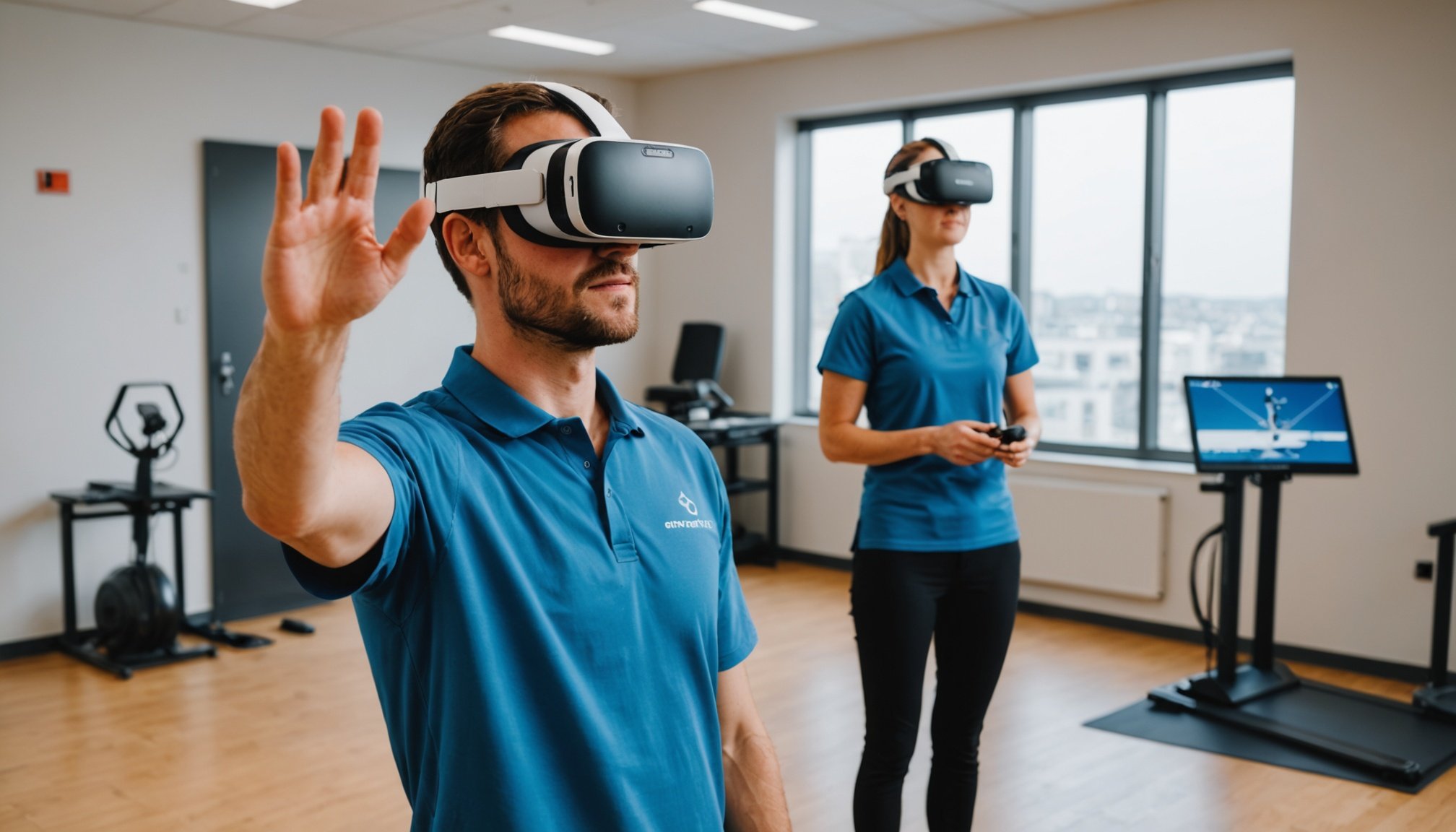Overview of Virtual Reality in Rehabilitation
Virtual reality (VR) technology has become an indispensable tool in modern rehabilitation. By creating immersive and interactive environments, VR allows patients to engage in therapeutic exercises that are both enjoyable and effective. This advancement in patient care not only motivates individuals through engaging scenarios but also provides real-time feedback, enhancing overall recovery rates.
In contemporary therapeutic settings, VR applications are diverse and widespread. For instance, it is used in physical rehabilitation to simulate environments where patients practise movements, improving their mobility post-injury. Additionally, VR technology offers psychological benefits by aiding cognitive rehabilitation, particularly in individuals recovering from strokes or brain injuries. This tailored approach ensures that the rehabilitation process accommodates individual needs and circumstances.
Topic to read : Transforming Weight Management: The Role of Digital Health Platforms in Supporting Obesity Patients
Technological advancements continue to drive significant changes in rehab practices. Enhanced graphics and improved sensory feedback have elevated the patient care experience, making therapies more personalised and precise. The integration of VR with artificial intelligence further promises to revolutionise rehabilitation by providing adaptive scenarios that respond to patient progress.
By embracing VR technology, the rehabilitation sector is poised to deliver unprecedented levels of care, vastly improving outcomes for patients worldwide.
This might interest you : Boosting Treatment Success: The Impact of Early Thyroid Disorder Detection on Patient Outcomes
The Role of Avatars in Virtual Reality
In the dynamic world of virtual reality, avatars serve as the digital representation of users, fundamentally shaping the level of immersion and quality of user interaction.
Definition and Function of Avatars
An avatar is a virtual representation, often resembling humanoid forms, designed to be the user’s identity in a digital environment. Their primary function is to enable users to interact with the virtual world and other users within it. This interaction can mirror real-world gestures and communication, creating a sense of presence.
Types of Avatars Used in Rehabilitation
In rehabilitation contexts, avatars are tailored to support therapeutic practices. They might be simple representations to guide exercises, or more complex forms that engage users in cognitive and physical activities. Tailored avatar designs enhance user experience by aligning with individual rehabilitation goals.
Interaction Between Patients and Avatars
Interaction with avatars in rehabilitation often relies heavily on customization. Allowing patients to personalize their avatar can significantly enhance engagement and motivation, potentially improving therapeutic outcomes. The integration of realism in avatar design also contributes to a more believable and effective experience, enabling smoother and more natural interactions.
Benefits of Avatars for Patient Engagement and Motivation
The use of avatars in therapy sessions significantly enhances patient engagement by creating a more personalised and interactive experience. This innovative approach allows individuals to express themselves more freely, often leading to deeper involvement during sessions. When patients see an avatar that represents them, it fosters a unique connection, making the therapeutic process more relatable and less intimidating.
Psychological Benefits
Avatars also provide psychological benefits by reducing anxiety and improving motivation. The detachment offered by interacting with a virtual representation can lessen self-consciousness. This encourages open dialogue and self-expression, which are essential for effective therapy outcomes. The sense of anonymity can help in easing individuals into discussions they might otherwise shy away from.
Traditional Methods vs. Avatar-Driven Engagement
Unlike traditional therapeutic methods, avatar-driven engagement offers a dynamic platform where patients can simulate real-life scenarios. This method can lead to better therapy outcomes as it allows for role-playing exercises and provides immediate, visually engaging feedback. Traditional methods, which often rely on face-to-face dialogue or pre-set activities, may not capture a patient’s attention as effectively as an interactive avatar can. This contrast highlights avatars’ potential to transform patient interaction and motivation, ultimately revolutionising therapy.
Case Studies and Real-Life Examples
Examining real-world success stories provides valuable insights into the practical applications of technology.
Successful Implementation in Clinical Trials
Clinical trials have showcased the transformative power of virtual reality (VR) and avatars in healthcare. For instance, VR-assisted procedures have significantly reduced pre-surgery anxiety in patients. The precise control offered by VR environments enhances training for medical professionals, contributing to improved outcomes. Avatars have been employed as therapeutic agents in mental health, where patients interact with digital figures to confront phobias or anxieties, demonstrating measurable progress.
Feedback from Healthcare Professionals
Healthcare professionals, central to successful implementation, offer essential feedback. They have noted that VR-based training modules allow for repeated, risk-free practice, leading to better procedural precision. Additionally, the use of avatars in therapeutic settings is reported to be beneficial for patient engagement, making challenging therapeutic tasks more inviting.
Patient Testimonials and Experiences
Patient testimonials highlight the impact of avatars and VR technology. Patients frequently mention feeling more comfortable addressing their mental health issues with avatars representing facets of themselves or their challenges. Personal accounts from patients consistently speak to enhanced engagement and reduced treatment-related stress, underscoring the human side of technological interventions.
Challenges and Limitations of Using Avatars
Utilising avatars in technology presents several challenges and limitations. One significant challenge is related to avatar customization. Limited options can hinder a user’s ability to create an avatar that resonates personally, potentially impacting user engagement. This issue is further complicated by technological barriers, such as the lack of advanced graphic capabilities on some devices, which can limit customization further.
Another essential consideration is accessibility issues across different patient demographics. While avatars offer a novel way to connect with technology, not all individuals have equal access or familiarity with these tools. Older demographics might find adapting to these new technologies particularly challenging, impacting their overall experience and effectiveness.
Concerns about technology reliability and efficacy also arise. Users may experience glitches, lags, or even disconnection, which can disrupt the experience. For instance, in a clinical setting, interrupted or inefficient interactions can have significant consequences for patient care and satisfaction.
Despite the evident benefits avatars bring to user interaction and engagement, addressing these technological barriers and ensuring a more inclusive design approach is crucial. This way, avatars can achieve their intended potential without leaving some users behind.
Future Trends and Research Directions
Exploring the future trends in the realm of virtual reality (VR) rehabilitation showcases a vibrant landscape filled with potential and innovation. As VR technology matures, its application in therapeutic sectors promises profound transformations.
Evolving Technologies in VR Rehabilitation
Recent advancements are reshaping the VR landscape, particularly in the field of rehabilitation. Novel technologies are focusing on personalising treatments through user-specific avatars, which adapt to the individual’s needs, enhancing treatment outcomes. This evolution in technology is underpinned by research that encourages continuous innovation in user engagement and therapy effectiveness.
Integrating AI with Avatar Functionality
Integrating artificial intelligence with avatars serves as an exciting avenue explored by researchers. AI can revolutionise avatar functionality, offering real-time feedback and personalised adjustments during rehabilitation. This synergy aims to create a seamless interaction where avatars respond intelligently to user inputs, making therapy sessions more effective and engaging.
Anticipated Research Developments
Looking ahead, anticipated research will likely delve into the long-term impacts of VR on rehabilitation processes. With a focus on emerging technologies, current studies are evaluating how avatars can evolve to better serve therapeutic purposes. Predictions suggest that continuous innovation will further embed avatars in rehabilitation, making therapies more immersive and outcome-focused. This proactive exploration and advancement in VR technology hold significant promise for future therapeutic applications.
I’m sorry, it looks like there was a part of your input missing or not provided which I need to write the section you requested. Could you please provide the necessary details such as the Section Outline or Review Summary?











